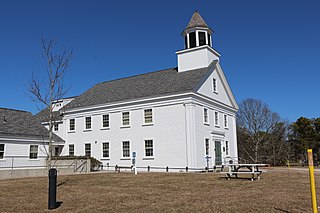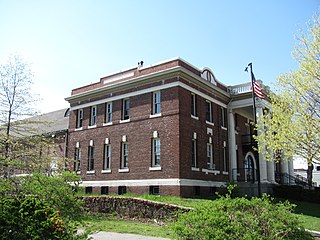
This is a list of the National Register of Historic Places listings in Barnstable County, Massachusetts.

Hamilton Hall is a National Historic Landmark at 9 Chestnut Street in Salem, Massachusetts. Designed by noted Salem builder Samuel McIntire and built in 1805–1807, it is an excellent instance of a public Federal style building. It was built as a social space for the leading families of Salem, and was named for Founding Father and Federalist Party leader Alexander Hamilton. It continues to function as a social hall today: it is used for events, private functions, weddings and is also home to a series of lectures that originated in 1944 by the Ladies Committee.

The Universalist Society Meetinghouse is an historic Greek Revival meetinghouse at 3 River Road in Orleans, Massachusetts. Built in 1834, it was the only Universalist church built in Orleans, and is architecturally a well-preserved local example of Greek Revival architecture. The Meeting House is now the home of the Orleans Historical Society and is known as the Meeting House Museum. It was listed on the National Register of Historic Places in 1999.

Old Town Hall is a historic town hall in Athol, Massachusetts. Built in 1828 as a church, it served as town hall from 1847 to 1957, and now houses the local historical society. It is architecturally a good example of Federal period civic/religious architecture of the period. It was added to the National Register of Historic Places in 1987.

The Brewster Old King's Highway Historic District is a historic district encompassing much of Massachusetts Route 6A and portions of some adjacent roads in Brewster, Massachusetts, which was known as the Old King's Highway during colonial times. The center of Brewster grew around the junction of the Old King's Highway and Harwich Road, with its first church built there in 1700, and a nearby burying ground established in 1707. The civic and commercial functions of the town were spread along the Old King's Highway through the 19th and into the early 20th century. This concentration of historic resources extends about 1.5 miles (2.4 km) west of the main junction, and about 1.2 miles (1.9 km) eastward.

The Norfolk Grange Hall, previously known as First Baptist Church, is a historic Grange hall and former Baptist church at 28 Rockwood Road in Norfolk, Massachusetts. Built in 1863, it is one of the town's few surviving 19th-century civic buildings. Since 1921 it has been owned by the Norfolk Grange # 135 and used as its meeting hall. It was listed on the National Register of Historic Places in 1989.

The Marstons Mills Community Church, formerly the Methodist Church, is a historic church building in the Marstons Mills village of Barnstable, Massachusetts. The white clapboard church was built in the town of Yarmouth, and moved to Marstons Mills in 1830. Its small belfry tower was added sometime between 1888 and 1908, around the same time it acquired some of its Queen Anne stylistic elements. In 1987, the church was listed on the National Register of Historic Places for its architecture and for its role in community history.

The Municipal Group Historic District is a historic district encompassing a cluster of five municipal buildings in the Hyannis village of Barnstable, Massachusetts. Included are the library, old town hall (1926), two buildings currently housing town offices that were originally part of the Hyannis Normal School, and the Crowell/Guyer Barn, a 19th-century structure now used by the local public works department. The district was listed on the National Register of Historic Places in 1987.

The Old King's Highway Historic District encompasses what was historically the principal east–west thoroughfare through Barnstable, Massachusetts. It encompasses Barnstable's entire length of what is now designated Massachusetts Route 6A and called Main Street, between the town lines of Sandwich and Yarmouth. It includes more than 1,000 acres (400 ha), and includes all of the buildings whose properties front on the road, nearly 500 in all. The area includes the main population centers of Barnstable from its founding in the late 1630s until the mid-19th century, when the southern parts of the community became more significant in economic prominence. The district was listed on the National Register of Historic Places in 1987.

Truro Town Hall, formerly Union Hall, is the town hall of Truro, Massachusetts. It is located on Town Hall Road, east of Massachusetts Route 6. The two story wood-frame building was built in 1848 to serve as a meeting place for several fraternal organizations, including the International Order of Odd Fellows and the Sons of Temperance. It served these organizations for only a few years, and was rented by the town for town meetings for a time before being purchased by the town. The building exhibits Greek Revival features, including corner pilasters and a deep architrave. The roof is topped by an octagonal cupola mounted on a square structure.

The Teaticket School is a historic former school building at 340 Teaticket Hwy in Falmouth, Massachusetts. Built in 1927, this large Colonial Revival building was the first consolidated elementary school in the town. It has since 1967 served as the Administration Building for the Falmouth Public Schools. It was listed on the National Register of Historic Places in 2002.

The Bernardston Congregational Unitarian Church is a historic church building at 49 Church Street in Bernardston, Massachusetts. The church is notable for the history of construction, movement, and reconstruction, since it was first erected in 1739, just two years after Bernardston was settled. It was added to the National Register of Historic Places in 1993. Its congregation is affiliated with the Unitarian Universalist Association which was established in 1820.

The former Reading Municipal Building is a historic building at 49 Pleasant Street in Reading, Massachusetts. Built in 1885, this two-story brick building was the town's first municipal structure, housing the town offices, jail, and fire station. In 1918 all functions except fire services moved out of the building. It now serves as Reading's Pleasant Street Senior Center. The building was listed on the National Register of Historic Places in 1984.

The Massachusetts State Armory is a historic armory in Wakefield, Massachusetts. Built in 1913, it is a fine local example of Classical Revival architecture, and a symbol of the town's long military history. The building was listed on the National Register of Historic Places in 1989. It presently houses the Americal Civic Center, a local community center.

The Peterborough Town House is the town hall serving Peterborough, New Hampshire. Located at Grove and Main Streets in downtown, the 1918 building is a significant local example of Colonial Revival architecture, and was listed on the National Register of Historic Places in 1996.

The Barnstable Fair Hall or Barnstable Agricultural Hall was an exhibition hall located in Barnstable, Massachusetts that was listed on the National Register of Historic Places on March 7, 1979. It was leveled by fire in the early morning of April 2, 1980. In the early 1990s, the structure was re-built as a condominium complex. In 1856 and 1857, land around the present building was given and sold to the Agricultural Society for use as a fairground. Total acreage of the property eventually exceeded twenty acres and extended as far back as the Maraspin Creek, a tidal stream. In 1857- 1858 a building "for exhibition purposes and a hall for public meetings" was built on the site of the present building. In February 1862, this first fair hall was destroyed by a gale, resulting in the formation of a building committee in April 1862 and the construction of the new structure between June 17 and October 14, 1862. Money for building costs came from private subscription, to which William Sturgis, a Boston merchant and native of Barnstable, was the major donor. Praised as being "superior in taste to the old" hall, the new Fair Hall was dedicated at the Barnstable County Fair of 1862 and served as the exhibition hall for all subsequent annual fairs until 1931 when the fair ceased to be held regularly. The fair is now held on an annual basis in Falmouth. During the period in which this property served as a fairground, there were additional shed and storage buildings to the north and east of the Fair Hall, as well as a track for trotting races, baseball diamond and grandstand, all of which have been removed. In addition to the usual exhibits of livestock and agricultural products, turn-of-the century fairs had vaudeville performances, balloonists, and other entertainments.

Barnstable, Massachusetts, has more than 75 entries on the National Register of Historic Places. For listings elsewhere in Barnstable County, see National Register of Historic Places listings in Barnstable County, Massachusetts.

The Weare Town House is a historic New England meeting house on New Hampshire Route 114 in Weare, New Hampshire. Built in 1837, it is a good example of a period town hall/church combination with Federal and Gothic Revival features. Although its religious use has ended, it continues to be used for town offices as well as civic and social functions. The building was listed on the National Register of Historic Places in 1985.

Stevens Memorial Hall is the historic town hall of Chester, New Hampshire. The building, a large wood-frame structure completed in 1910, is located in the center of Chester at the junction of New Hampshire Routes 121 and 102. The building was listed on the National Register of Historic Places in 2004. It served as the center of the town's civic business until 2000, when town offices were relocated to a former school.

The District No. 4 School, also known as the First East School or Ledgeville School, is an historic school building at 191 East Road in Petersham, Massachusetts. Built in 1846, it is one of the town's older surviving district school buildings, and now serves as a local community hall. It was listed on the National Register of Historic Places in 2016.

























